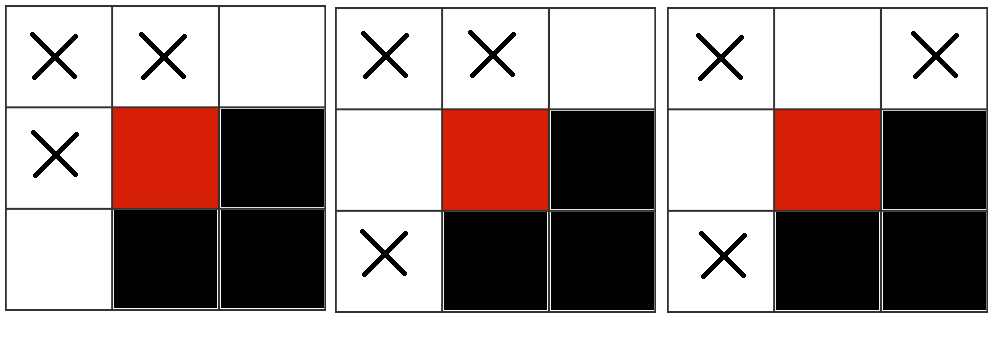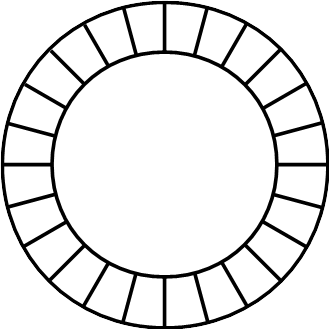Tic-Tac-Toe without the middle square
In a modified version of tic-tac-toe , the middle square is blocked from play.
If this game is played optimally, who will win?
This section requires Javascript.
You are seeing this because something didn't load right. We suggest you, (a) try
refreshing the page, (b) enabling javascript if it is disabled on your browser and,
finally, (c)
loading the
non-javascript version of this page
. We're sorry about the hassle.
16 solutions
Hey! Can you please use images, I'm having a hard time visualizing this in my head.
Log in to reply
I'm not sure quite how to implement your suggestion. I've improved the picture that was already there, but I don't know what other image I could add, as any other case is just an invalid situation to the logic, and it would not progress the argument. Really there is only 1 case to consider here, I think it more picture just make the solution harder to understand. If you can't see why no other case will work besides the one that is shown, you can try drawing it out, but I think that if you understand the logic well it shouldn't be too hard to visualize.
Log in to reply
No, since the play here is not optimal.
No matter how the game is played, each player has four pieces to place. Since the threat is created when making two optimal turns, either the second player blocks the line, or he can place two pieces on corners.
Why is that the only way to create a 'double threat'? I can see that (ignoring rotations) the 3 Xs have to be able to control the top and left of the grid, and that the 2 Os must therefore be in the bottom right three squares. But what about the following?
–X–
–M–
XOO
becomes
XX–
–M–
XOO
I'm not suggesting that this would be a valid optimal move for the second player. I'm just saying that it's another way to create a 'double threat'.
Log in to reply
I think you are actually correct. I'm not sure why nobody else noticed it, but unless I'm forgetting something, that seems totally valid to me. Actually, Zain Majumder had that observation in his solution, and he points out 3 ways to do it.
Log in to reply
The placement of the double threat would be already determined in the first diagram, so it would make sense for the opponent ("O" in this situation) to put O in the top left corner to avoid both possible threats.
 (
O
and
X
) no one of them haven't any force to win the game
(
O
and
X
) no one of them haven't any force to win the game
The above ( G I F ) shows a scenario for our condition.
The central cell is the most stratigical cell of the game.
If we block the central cell of the game then no body won't be can win the game. Each play only can avoid from losing.
Note: The above Theory only respond for that each player play optimally the game.
How did you make the GIF?
Log in to reply
With two applications in Android.
You can download them from app store.
Gif maker-Gif editor(Kayak studio is the publisher). , Tic toc toe glow (Arctlite system is publisher)
Relevant wiki: Tic Tac Toe
The only way to win even if both players play optimally is to force a trap, where two two-in-a-rows are created at once. There are many ways to do this, but they all fall into one of the three types shown below:

The white squares must also be empty, and the X in the top-left corner must be placed last. O has to block the trap before X places their final piece.
If X places their piece in a square between two corners (options 1 and 2), O can simply block that entire row by placing their piece in an adjacent square. If X places their piece on a corner square (options 2 and 3), O can play in the opposite corner, which must also be part of the trap. Therefore, O can block any trap X tries to make and vice versa. The game must end in a draw.
I have a small doubt. What if X places their piece in diagonally opposite corners first and places 3rd turn in another corner?
Log in to reply
Using the strategy above, O should block the opposite corner before X can place a piece there.
I propose to consider another modified version of tic-tac-toe, which I'll call the n-circular modified tic-tac-toe, for lack of a better name:
 The rules of placement and winning are the same, whoever got first their three marks in a row, win.
The rules of placement and winning are the same, whoever got first their three marks in a row, win.
 I assume the first player (mark X) have the advantage because he is the first to put its mark. Any place where he puts the first mark (fig.1), he creates a single segment of unoccupied places limited only by its mark, which for convenience I call a XX segment . The second player (mark O) must answer with a connected mark to the first because if not, next time, the first player will build a -XX- configuration where we can win by marking one the two placeholders "-" (fig.2). But by answer with a connected mark, the segment XX will be converted into a XO one, one terminated by two different marks.
I assume the first player (mark X) have the advantage because he is the first to put its mark. Any place where he puts the first mark (fig.1), he creates a single segment of unoccupied places limited only by its mark, which for convenience I call a XX segment . The second player (mark O) must answer with a connected mark to the first because if not, next time, the first player will build a -XX- configuration where we can win by marking one the two placeholders "-" (fig.2). But by answer with a connected mark, the segment XX will be converted into a XO one, one terminated by two different marks.
The aim of the first player is to get marks dispositions like X-X (a XX segment) or XX- and playing in the placeholder -, win the game. The strategy to defend against this is simple: Each time the first player puts his mark into a XO segment (like X----O),...
1) ...creating an XX segment (like in X--X-O), the second player answers with a connected mark to the previous in such a way that it converts that XX segment into a XO one (like X-OX-O). This way, the first player never gets the chance to play into a XX segment, since the second player will destroy them as fast as the first creates them. (fig.3)
2) ...connected with its own mark (like in XX----O), the second will again connect this mark with his own, converting the XX segment into a OO. The roles are reversed, and now, the first player must be the one in the defensive. This happens because, since the defender player are always connecting to the previous move, all segments are terminated by pairs OX, and extending it with a X (OXX_) doesn't creates a double threat. (fig.4)
The tic-tac-toe of the problem is the same as an 8-circular modified tic-tac-toe with the following difference: the set of winning configurations of the former is a subset of the later. So, if it is not possible to warrant a winning configuration in the 8-circular modified tic-tac-toe, it is not possible to get it in the modified tic-tac-toe of the problem either.
We might however question if by having less winning configurations, this allows the second player to ignore certain threats and win the initiative. But this doesn't do it, since we already saw that to won the advantage is not enough to win the game.
This is a very nice approach. I like the fact that instead of analyzing the game directly, you first generalized it and then analyzed it. Also, I would encourage you to go ahead and post a problem about this game.
Log in to reply
Thanks for your appreciation. I like to generalize because it is easier that way to control my reasoning errors. But in this case, it was more because everyone knows there is no absolute winning strategy in the normal tic-tac-toe, and so, even less in your modified game. The only thing that occurred to me to run from the normal tic-tac-toe, was to generalize... something your modified version allows easily in a natural way. Even so, I almost got it wrong because only later I perceived the 8-circular and your modified version are not isomorph versions of the same game. Also, I'm still not comfortable with my last sentence. Although I think it is logically correct, I keep thinking on an emotional level there might something there I'm overlooking. I'm not totally happy with this explanation.
PS.: Thanks for your encouragement.
Once the center is blocked, there are only two types of plays: corner and edge. It is obvious that player 2 cannot win because if there is a strategy, player 1 can execute that strategy. So the question boils down to: can player 1 win? Because there are 4 edges, there are 4 conditions to win: left, right, top, bottom. Each corner play creates/eliminates 2 possibilities and each edge play creates/eliminates 1 possibility to win. So here is player 2's strategy:
First play: play a corner where the opposite corner is not occupied and there is a shared edge between this play and player 1's first play. It must be possible because there are 2 pairs of opposite corners and player 1 has only made 1 play. If player 1 made an edge play, that play becomes useless because the possibility has been taken out, so player 1's optimal strategy would be to make a corner play.
Second play: If opposite corner is not occupied, play it. Game over because there is no way to win for player 1. If it is occupied, it must be the last play of player 1. The board will look like this
| 1 | 0 | 2 |
| 0 | x | 0 |
| 1 | 0 | 0 |
There is only one sensible play for player 2 now, which is block player 1.
| 1 | 0 | 2 |
| 2 | x | 0 |
| 1 | ? | ? |
Third play: the question marks are unoccupied after the second play. So for the third play, player 2 needs to take at least one of the question mark and the game becomes unwinnable. Because there are two question marks, player 1 cannot occupy both in one play. Hence the game is unwinnable. QED.
This is a bad question. It's theoretically possible for either to win or a stale. If the question is about the optimal tic tac toe strategy than nothing changes by blocking out one space. Doing so confused the purpose of the puzzle.
No. It is not possible for either to win if both played optimally.
The answer should be who plays first because if the first start filling the crosswise, it will win the game
Since there is an even number of boxes to play, each player will get the same number of moves during the game. Therefore if both players play optimally, neither the first nor second player has a greater chance of winning.
This logic is not necessarily correct. For example, if you won upon getting 2-in-a-row rather than 3-in-a-row, your logic still holds, as the grid would be the same, however, the first player has the winning strategy.
No one can win if both people are decent. If x goes bottom corner of just has to go opposite and no one can win, Henceforth the game being undoable.
The middle is the best place for moves. Blocking it means that the second player just has to block all the time or he loses. If he blocks all the time, it will be a draw.
A player requires three chances to win but a opponent player can stop other player to win in 2 chances by marking on the diagonal squares .
More columns got blocked, less possibility for anyone to win or loose. Hope this helps.
If the game is played optimally, it will be always a draw because there are no diagonal wins.
Actually, if the game is played optimally, nobody can win as the players are of equal calibre and it doesn't really matter whoever plays first.
Let’s say x starts first. X puts it on one corner. O puts it next to it. If they keep on outing it next to each other, nobody would win.
El jugador 2 bloqueará los intentos del jugador 1 y este no puede hacer ningún truco porque la parte fundamental es la diagonal y está bloqueada.
Imagine taking the grid and arranging the boxes so that they are in a line.
Winning the game is now reduced to one-lined "connect 3".
The grid can be shifted back and forth, which is just another possible arrangement.
eg. [O][X][O][X][X][O][O][X]
Neither player can win, because it takes 3 turns to connect 3, but only 2 turns to block both sides of a symbol.
You can think of it as neither player having enough tempo.
Relevant wiki: Tic Tac Toe
Suppose the first player, controlling X's were to win a game. Then, the turn before he wins, he would need to create a 'double threat', as otherwise his attack would have been blocked. In order to create a double threat, X will need to place his piece on a corner square, as edge squares can only threaten 1 row or column at a time, since they are only on 1 row or column. From this position, X will need to create 2 threats, one in the same column, and one in the same row. (Some ways X can do so are depicted below)
Now, to create a double threat in the top and left rows, O must have no pieces in these rows. Hence, O can guarantee X's defeat by using the first 2 turns to take 2 different corners. So the first player cannot win.
Additionally, it is clear that the second player cannot win, as we can use the same strategy. Hence, if both players play optimally, there can be no winner.